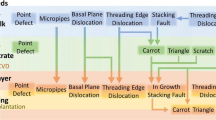Abstract
When a high-velocity (i.e., typically > 0.1 MeV/amu) ion passes through a material it can change the properties of the material within a cylindrical zone centered on the essentially straight trajectory of the ion. The electronic bonding, phase, and density are among the properties modified in the zone, which is called a latent nuclear, or ion, track. Because the diameters of latent ion tracks are typically less than 20 nm, selective chemical etching is generally employed to improve the detection and assessment of the tracks. Historically, etched nuclear tracks have been used mainly for nuclear particle identification, geochronology, measurement of extremely low-dose radiation levels, and creation of membrane filters.
Similar content being viewed by others
Reference
R. Spohr, Ion Tracks and Microtechnology: Principles and Applications (Vieweg, Braunschweig, Germany, 1990).
A. F. Bernhardt, R. J. Contolini, A. F. Jankowski, V. Liberman, J. D. Morse, R. G. Musket, R. Barton, J. Macaulay, and C. Spindt, J. Vac. Sci. Technol. B 18, 1212 (2000).
T. S. Fahlen, presented at the 12th International Vacuum Microelectronics Conference, Darmstadt, Germany, 1999 (unpublished).
Author information
Authors and Affiliations
Rights and permissions
About this article
Cite this article
Musket, R.G. Applications of Ion Track Lithography in Vacuum Microelectronics. MRS Online Proceedings Library 621, 121 (2000). https://doi.org/10.1557/PROC-621-R1.2.1
Published:
DOI: https://doi.org/10.1557/PROC-621-R1.2.1




